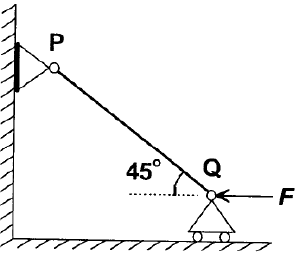Test: Theories of Column & Theories of Failure - 1 - Mechanical Engineering MCQ
20 Questions MCQ Test GATE Mechanical (ME) Mock Test Series 2025 - Test: Theories of Column & Theories of Failure - 1
The rod PQ of length L and with flexural rigidity EI is hinged at both ends. For what minimum force F is it expected to buckle?

A pin-ended column of length L, modulus of elasticity E and second moment of the cross -sectional area I is loaded centrically by a compressive load P. The critical buckling load (Pcr) is given by:
| 1 Crore+ students have signed up on EduRev. Have you? Download the App |
The piston rod of diameter 20 mm and length 700 mm in a hydraulic cylinder is subjected to a compressive force of 10 KN due to the internal pressure. The end conditions for the rod may be assumed as guided at the piston end and hinged at the other end. The Young’s modulus is 200 GPa. The factor of safety for the piston rod is
A structural member subjected to an axial compressive force is called
An axle is a machine part that is subjected to:
Mach List-I with List-II and select the correct answer using the codes given below the lists:
Assertion (A): A long column of square cross section has greater buckling stability than a similar column of circular cross-section of same length, same material and same area of cross-section with same end conditions.
Reason (R): A circular cross-section has a smaller second moment of area than a square cross-section of same area.
Match List-I (End conditions of columns) with List-II (Equivalent length in terms of length of hinged-hinged column) and select the correct answer using the codes given below the Lists:
What is the expression for the crippling load for a column of length „l‟ with one end fixed and other end free?
For the case of a slender column of length L and flexural rigidity EI built in at its base and free at the top, the Euler‟s critical buckling load is
Euler's formula can be used for obtaining crippling load for a M.S. column with hinged ends.
Which one of the following conditions for the slenderness ratio 1/k is to be satisfied?
If one end of a hinged column is made fixed and the other free, how much is the critical load compared to the original value?
The ratio of the compressive critical load for a long column fixed at both the ends and a column with one end fixed and the other end free is:
A long slender bar having uniform rectangular cross-section 'B x H' is acted upon by an axial compressive force. The sides B and H are parallel to x- and y-axes respectively. The ends of the bar are fixed such that they behave as pin-jointed when the bar buckles in a plane normal to x-axis, and they behave as built-in when the bar buckles in a plane normal to y-axis. If load capacity in either mode of buckling is same, then the value of H/B will be:
If σc and E denote the crushing stress and Young's modulus for the material of a column, then the Euler formula can be applied for determination of cripping load of a column made of this material only, if its slenderness ratio is:
Rankine Gordon formula for buckling is valid for
Mach List-I with List-II and select the correct answer using the codes given below the lists:
Which one of the following statements is correct?]
Assertion (A): Buckling of long columns causes plastic deformation.
Reason (R): In a buckled column, the stresses do not exceed the yield stress.
Which one of the following pairs is not correctly matched?
|
29 docs|220 tests
|
|
29 docs|220 tests
|

















